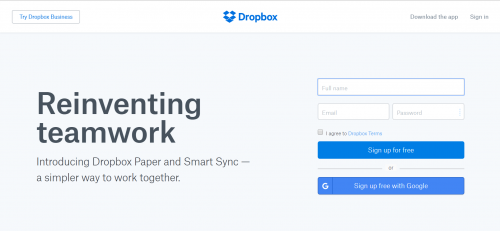SaaS pricing best practices are what turn software-as-a-service (SaaS) startups into a profitable business. However, the complex web of incentives for customers and businesses-across various industries and product types-offered by various pricing models are dizzying.
To help you find the best SaaS pricing model, we’ve looked at some of the most popular pricing structures employed by a few of the most successful SaaS empires.
SaaS Pricing Best Practices:
Pricing Model Creates Demand
Before offering a “freemium” pricing model -where users can opt for a trimmed-down service for free or a full service for charge- Dropbox primarily used paid search at a cost of $194 per user.
Founder and CEO Drew Houston said this acquisition method was effective at capturing existing demand for their products, but poor for their most critical goal: creating additional demand.
The company pivoted to a freemium model with strong incentives for user referrals.
And it worked.
Between January 2010 and November 2013, Dropbox’s user base grew from four million to 200 million. More value was extracted per customer by testing and refining the free and premium offerings and incentives to refer, according to Houston.
“It’s hard to master freemium products unless you can build an organic customer acquisition engine. If you think of your free user costs as your marketing budget, then things begin to make more sense.”
Freemium isn’t for every business, though. It’s often hard to convince some to pay what others get for free. Likewise, it’s not easy to get free users to pay for a sufficiently better product to justify paying a premium for something they previously got for free.
Additionally, freemium customers expect services to evolve. Since Dropbox began, the company has evolved its offerings from providing cloud storage space to a sleek file management UI with collaboration and automatic upload features. This means the freemium model works best for companies committed to improving their products and expanding their functionality indefinitely.
Free trials are almost ubiquitous
The calculus for free trials is simple: give your customers enough of a taste to get hooked, then offer them the full meal on a silver platter-for a cost.
In fact, they’re so effective that they double as a SaaS marketing strategy, driving high levels of adoption and traffic to your site, which is why they’re nearly a de-facto strategy for SaaS companies, according to Kenn Devane, CEO of consultancy firm MineTech.
“Very few people are going to give you a bunch of money to try something if they are already using a product that works. I think you have to do a free trial.”
The question isn’t whether you should offer a free trial, but whether to offer a free trial or provide a freemium offering.
Companies with wider customer bases generally benefit more from freemium products, while the free trial model works better for companies with niche audiences.
Additionally, free trials are best suited for services that provide most of their value right away while the value of freemium products increase in value the better customers understand and use it.
Per usage pricing offers transparency
Like freemium, per usage pricing is as much marketing as it is finance.
Twilio, a leading cloud communications platform, works by helping application developers connect their apps to telecom-prided services-like phone calls and texts. Users are charged for each time their application requests telecom services from Twilio.
In a speech at the Business and Software Conference, Twilio founder Jeff Lawson said he chose the company’s simple pricing model to contrast with enterprise providers, who typically have a slow and opaque sales process that invites distrust and obscures the product’s core functionality.
“They want to keep it a mystery… if you really want to figure out if a software solves your problem, you’re going to call the sales guy and the sales guy is just going to tell you that it solves your problem, whatever you say your problem is.”
Twilio’s pricing page is the antithesis of this approach:
Each service that’s provided is itemized and given a per usage price. The subtext: customers are only charged when Twilio does their job right.
This strategy is credited as behind much of the success of the now-public company. Founded in 2007, Twilio was recently valued at $1.2 billion, generating $277.34 million in revenue in 2016.
Per usage pricing often used with SaaS products that provide some sort of transactional infrastructure-based services, like payments, cloud storage, or data.
Fixed prices are irresistibly simple but extract less value
Among the greatest drawbacks of the above methods is their complexity and the irrational they cause to customers.
Tiered and freemium pricing denies the full product experience to free and low-tier customers, per user pricing can appear exploitive and become cumbersome, and users stop feeling like they hit the jackpot once the trial period ends.
In our lives outside of work, most of the purchases are for fixed products and services. SaaS companies can take advantage of our instinctual desire for crystal clear, simple pricing by offering fixed pricing-something GoToMeeting has taken advantage of to great success.
GoToMeeting, a video conferencing provider, changed their financing model from a service marketplace to SaaS to better compete with SaaS providers like WebEx. Extensive customer research revealed that customers from WebEx were frustrated the pricing model, which charged a significant setup fee, a per attendee fee, and a fee based on the length of each meeting.
Recognizing that this dis-incentivized users from actually using the service for its designated purpose, GoToMeeting opted for a flat monthly fee, helping the company better compete and attract customers away from WebEx.
For many companies, though, fixed pricing, poses the risk of your most devoted users using up a disproportionate amount of resources. It’s also hard to get more value out of heavy users, current users, and varieties of product use cases.
Your customers will lead you to the right price
Ultimately, SaaS pricing best practices are specific to your industry, market share, customer base, and service, among many other factors. The key to finding the right model for your company boils down to relentless user testing, according to Twilio’s Jeff Lawson.
“Do you have the right price? That’s a question that now; only interactions with customers will tell you. So you need some feedback loops, you need some ways of testing things with customers and seeing if it’s gonna work.”



